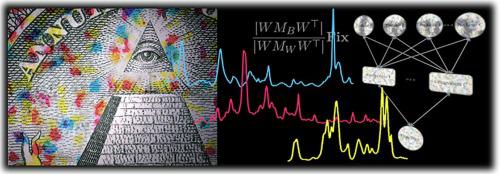Forensic Chemistry ( IF 2.7 ) Pub Date : 2021-03-23 , DOI: 10.1016/j.forc.2021.100336 Patrick Buzzini , James Curran , Carrie Polston

|
Inkjet printers are devices that are frequently used in illicit activities like threats, extorsions, or the production of counterfeited currency. In these cases, scientific information may play a critical role to develop investigative leads and assist investigators with the designation of potential printer source candidates. Raman spectroscopy was used to analyze the three main colored dot components (cyan, magenta, and yellow) of inkjet printed documents. Three variants of linear discriminant analysis (LDA) were evaluated on 231 Raman spectra of a set of 11 inkjet printer ink samples, which were previously compared visually. The three LDA variants were: 1) Principal component analysis (PCA) followed by LDA, 2) Partial least square discriminant analysis (PLSDA) and 3) sparse LDA. The classification accuracy of the selected classifiers was evaluated as well as their detection sensitivity to the level of detail that analysts should typically use during spectral visual comparisons. These evaluations were made for each dot color and also for their joint use. Results showed that although spectral visual comparisons are still superior to differentiate Raman spectra on the basis of minor peaks, sparse LDA provided the highest classification potential (i.e., highest accuracy) for individual colors, and that the three methods performed equivalently when the spectral data from the three colors were combined. It was also determined that baseline correction was not a factor that affected the performance of the used classifiers, but it was found that normalization was a necessary step prior to data analysis.
中文翻译:

视觉评估与线性判别分析的不同变体之间的比较,以对喷墨打印机墨水的拉曼图案进行分类
喷墨打印机是经常用于非法活动中的设备,例如威胁,勒索或制造假币。在这些情况下,科学信息可能会发挥关键作用,以开发调查线索并协助调查人员指定潜在的打印机来源候选人。拉曼光谱法用于分析喷墨打印文档的三个主要的彩色点成分(青色,品红色和黄色)。在一组11个喷墨打印机墨水样品的231拉曼光谱上评估了线性判别分析(LDA)的三种变体,这些光谱先前已通过视觉比较过。这三个LDA变体是:1)主成分分析(PCA),然后是LDA,2)偏最小二乘判别分析(PLSDA)和3)稀疏LDA。评估所选分类器的分类准确性,以及它们对分析人员在光谱视觉比较中通常应使用的详细程度的检测灵敏度。这些评估是针对每个点的颜色及其共同使用的。结果表明,虽然光谱视觉比较仍然优于基于次要峰的拉曼光谱,但稀疏LDA为每种颜色提供了最高的分类潜能(即,最高的准确度),并且当光谱数据来自三种颜色结合在一起。还确定基线校正不是影响所用分类器性能的因素,但是发现在进行数据分析之前,标准化是必不可少的步骤。


























 京公网安备 11010802027423号
京公网安备 11010802027423号